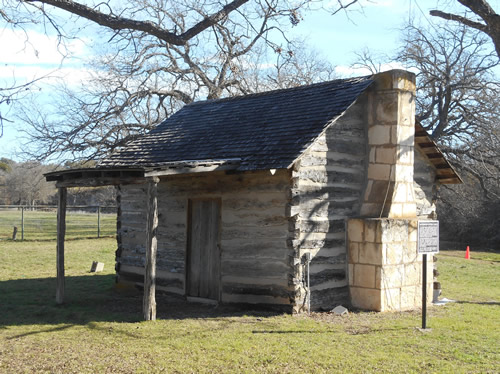Books by
Michael Barr
Order Here: |
|
Harper
Pioneer Museum
Photo courtesy Michael Barr, February 2020 |
Located
on the high divide in far western Gillespie
County, Harper, Texas is out there on the edge; connected to the
German Hill Country in some ways and separated from it in others.
Harper is famous for its healthy climate. A whimsical reporter once
compared Harper to a similar town in Oklahoma where, "the town graveyard
was a measly little patch in which only 3 lots had been taken and
the occupants of those were 3 doctors who had tried to make a living
there and starved to death because the people were so healthy."
A Spanish army officer named Francisco Amangual was one of the first
Europeans to see the area we now call Harper. On March 30, 1808 Amangual
and 200 Spanish soldiers left San
Antonio for Santa Fe. The mission was to map a road between 2
of the most important towns on the northern Spanish frontier.
The soldiers trekked northwest from San
Antonio following the Pinta Trail.
In early April they reached the Pedernales
River near present-day Fredericksburg.
They followed the meandering river west through the area we now call
Tivydale, reaching the Pedernales headwaters on April 8, 1808 near
the spot where the town of Harper now stands.
"We traveled over terrain covered with flattened hills," Amangual
wrote in his diary, "which were rocky and thickly wooded with no view.
We traveled in this manner until about 10 o'clock in the morning when
we came to open country where there were some promontories and some
clumps of trees. We killed a bear and sighted a herd of buffalo off
in the distance."
The quality of the Pedernales country was apparent as the soldiers
moved farther west into what is today Kimble
County and found a coarser country with less water, more brush
and fewer live oaks.
After reaching Santa Fe in June, Amangual returned to San Antonio,
bringing word that the upper Pedernales Valley was peerless stock-raising
country.
Over 50 years later pioneer preacher Matthew Taylor and his extended
family moved to the area. Taylor built a cabin near what is today
the intersection of U. S. Highway 290 and the Kerrville Road.
In 1865 a band of Kiowas attacked the Taylor place, killing Matthew
Taylor's daughter-in-law Gill Taylor and son-in-law Eli McDonald.
The Kiowas took 6 hostages, later ransomed in Oklahoma.
Matthew Taylor's wife Hannah survived the ordeal by hiding in a cave
in what is now Harper Community Park. |
 |
McDonald
Cabin now in Harper Community Park
Photo courtesy Michael Barr, February 2020 |
Site
of McDonald Massacre
Photo courtesy Michael Barr, February 2020 |
The
1901 Presbyterian Church
Photo courtesy Michael Barr, February 2020 |
The
1914 St. James Lutheran Church
Photo courtesy Michael Barr, February 2020 |
McDonald
Massacre Historical Marker
Photo courtesy Michael Barr, February 2020 |
|
The
town is named for George Franklin Harper, born in Sangamon County,
Illinois in1828. Abraham Lincoln was Frank Harper's neighbor. Abe
split rails for Frank's father and borrowed books from Frank's grandmother.
Frank Harper came to Texas in 1848. He settled in Floresville
but needed more space for his growing herd of horses. In 1863 he
moved his herd to the open range straight west of Fredericksburg.
He built his home near the headwaters of the Pedernales
River.
Frank Harper helped establish the school and the bank at Harper.
His house served as the town's first post office.
When the town of Harper had no doctor, Frank Harper bandaged wounds
and set bones. He made caskets. He organized dances and community
events.
On April 1, 1909 J. Marvin Hunter began publishing a 4-page weekly
called the Harper Herald. Hunter printed the newspaper on
an old Washington hand press he found half buried in a sand bank.
He became a well-known writer, historian and publisher of Frontier
Times Magazine.
The bank began with a meeting in Captain Schreiner's office in Kerrville.
It opened for business after teamsters hauled in a 4,000 lb. safe
from a bank in Junction and installed it in the back of Mr. Barker's
store.
In the early 20th century Harper gained a reputation as a kind of
health resort. San Antonio newspapers touted Harper as having "the
best climate in Texas." City folks crammed the Harper Hotel every
summer to relax and breathe the pure invigorating air.
To this day the folks at Harper still brag about the climate.
"Except for that darned summer heat," an old-timer at the Longhorn
Café told me, "our weather is pretty close to perfect."
|
|
© Michael
Barr
"Hindsights"
April 1, 2020 Column
Sources:
"Harper and the Harper Country," Kerrville Mountain Sun,
November 6, 1909.
"First Written Record of Harper came in 1808," Kerrville Daily
Times, May 2, 1993.
Here's Harper, Centennial Committee, 1863-1963.
"Harper founded in the 1880s," Kerrville Daily Times, April
24, 1994.
|
|
|
